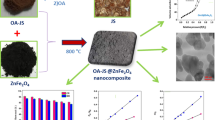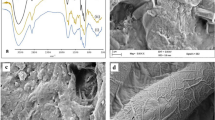Abstract
This study used lemon peel and Fe3O4 nanocomposite (LE-Fe3O4) to remove Congo red (CR) from the aqueous solution in batch adsorption techniques. The main factors influencing the adsorption process studied were pH, dose, contact time, and initial concentration. The results have shown the optimum conditions for making LE-Fe3O4 a suitable adsorbent were pH 6, 25 mg/50 mL dose, 90 ppm initial CR concentration, and 30-min contact time. The experimental data best fit with the Langmuir isotherm model with 16.28 mg/g max adsorption capacity and pseudo-second-order kinetic model, which indicates the monolayer chemisorption adsorption process. The properties of the nanocomposite adsorbent were established through X-ray diffraction (XRD), Fourier-transform infrared spectroscopy (FTIR), Brunauer–Emmett–Teller (BET), and Barrett-Joyner-Halenda (BJH).












Similar content being viewed by others
References
Thabede PM, Shooto ND, Naidoo EB (2020) Removal of methylene blue dye and lead ions from aqueous solution using activated carbon from black cumin seeds. S Afr J Chem Eng 33:39–50
Faisal AAH, Shihab AH, Naushad M, Ahamad T, Sharma G, Al-Sheetan KM (2021) Green synthesis for novel sorbent of sand coated with (Ca/Al)-layered double hydroxide for the removal of toxic dye from aqueous environment. J Environ Chem Eng 9:105342
Hamd A, Dryaz AR, Shaban M, AlMohamadi H, Abu Al-Ola KA, Soliman NK, Ahmed SA (2021) Fabrication and application of zeolite/Acanthophora spicifera nanoporous composite for adsorption of Congo red dye from wastewater. Nanomaterials 11(9):2441
Han R, Ding D, Xu Y, Zou W, Wang Y, Li Y, Zou L (2008) Use of rice husk for the adsorption of Congo red from aqueous solution in column mode. Bioresour Technol 99(8):2938–2946
Kumar KV (2007) Optimum sorption isotherm by linear and nonlinear methods for malachite green onto lemon peel. Dyes Pigments 74(3):595–597
Annadurai G, Juang RS, Lee DJ (2002) Use of cellulose-based wastes for adsorption of dyes from aqueous solutions. J Hazard Mater 92(3):263–274
Zhang LL, Lv S, Xu JG, Zhang LF (2018) Influence of drying methods on chemical compositions, antioxidant and antibacterial activity of essential oil from lemon peel. Nat Prod Res 32(10):1184–1188
Wang J, Zhai Y, Ou M, Bian Y, Tang C, Zhang W et al (2021) Protective effect of lemon peel extract on oxidative stress in H9c2 rat heart cell injury. Drug Des Devel Ther 15:2047
Rahdar A, Taboada P, Aliahmad M, Ha**ezhad MR, Sadeghfar F (2018) Iron oxide nanoparticles: synthesis, physical characterization, and intraperitoneal biochemical studies in Rattus norvegicus. J Mol Struct 1173:240–245
Jannah NR, Onggo D (2019) Synthesis of Fe3O4 nanoparticles for colour removal of printing ink solution. J Phys: Conf Ser 1245(1):012040
Takai ZI, Mustafa MK, Asman S, Sekak KA (2019) Preparation and characterization of magnetite (Fe3O4) nanoparticles by sol-gel method. Int J Nanoelectron Mater 12:37–46
Hu, P., Chang, T., Chen, W. J., Deng, J., Li, S. L., Zuo, Y. G., ... & Volinsky, A. A. (2019). Temperature effects on magnetic properties of Fe3O4 nanoparticles synthesized by the sol-gel explosion-assisted method. J Alloys Compd, 773, 605-611
Ehrampoush MH, Miria M, Salmani MH, Mahvi AH (2015) Cadmium removal from aqueous solution by green synthesis iron oxide nanoparticles with tangerine peel extract. J Environ Health Sci Eng 13(1):1–7
Lingamdinne LP, Vemula KR, Chang YY, Yang JK, Karri RR, Koduru JR (2020) Process optimization and modeling of lead removal using iron oxide nanocomposites generated from bio-waste mass. Chemosphere 243:125257
Reid TM, Morton KC, Wang CY, King CM (1983) Conversion of Congo red and 2-azoxyfluorene to mutagens following in vitro reduction by whole-cell rat cecal bacteria. Mutat Res/Genet Toxicol 117(1-2):105–112
Song Y, Wang K, Zhao F, Du Z, Zhong B, An G (2022) Preparation of powdered activated carbon composite material and its adsorption performance and mechanisms for removing RhB. Water 14(19):3048
Mohammed AA, Kareem SL (2019) Adsorption of tetracycline from wastewater by using Pistachio shell coated with ZnO nanoparticles: equilibrium, kinetic and isotherm studies. Alex Eng J 58(3):917–928
Al-husseiny RA, Ebrahim SE (2022) Synthesis of nano-magnetite and magnetite/synthetic geopolymer nano-porous composite for application as a novel adsorbent. Environ Nanotechnol, Monit Manag 18:100700
Šehović, E., Memić, M., Sulejmanović, J., Hameed, M., Begić, S., Ljubijankić, N., ... & Sher, F. (2022). Thermodynamic valorisation of lignocellulosic biomass green sorbents for toxic pollutants removal. Chemosphere, 307, 135737
Hariani PL, Faizal M, Ridwan R, Marsi M, Setiabudidaya D (2013) Synthesis and properties of Fe3O4 nanoparticles by co-precipitation method to removal Procion dye. Int J Environ Sci Dev 4(3):336–340
Herrera-Barros A, Bitar-Castro N, Villabona-Ortíz Á, Tejada-Tovar C, González-Delgado ÁD (2020) Nickel adsorption from aqueous solution using lemon peel biomass chemically modified with TiO2 nanoparticles. Sustain Chem Pharm 17:100299
Villen-Guzman M, Gutierrez-Pinilla D, Gomez-Lahoz C, Vereda-Alonso C, Rodriguez-Maroto JM, Arhoun B (2019) Optimization of Ni (II) biosorption from aqueous solution on modified lemon peel. Environ Res 179:108849
Threepanich A, Praipipat P (2021) Powdered and beaded lemon peels-doped iron (III) oxide-hydroxide materials for lead removal applications: synthesis, characterizations, and lead adsorption studies. J Environ Chem Eng 9(5):106007
Namasivayam C, Kavitha D (2002) Removal of Congo Red from water by adsorption onto activated carbon prepared from coir pith, an agricultural solid waste. Dyes Pigm 54(1):47–58
Harja M, Lupu N, Chiriac H, Herea DD, Buema G (2022) Studies on the removal of Congo red dye by an adsorbent based on fly-ash@ Fe3O4 mixture. Magnetochemistry 8(10):125
Vimonses V, Lei S, ** B, Chow CW, Saint C (2009) Kinetic study and equilibrium isotherm analysis of Congo red adsorption by clay materials. Chem Eng J 148(2-3):354–364
Namasivayam C, Muniasamy N, Gayatri K, Rani M, Ranganathan K (1996) Removal of dyes from aqueous solutions by cellulosic waste orange peel. Bioresour Technol 57(1):37–43
Paşka O, Ianoş R, Păcurariu C, Brădeanu A (2014) Magnetic nanopowder as effective adsorbent for the removal of Congo red from aqueous solution. Water Sci Technol 69(6):1234–1240
Jumadi, J., Kamari, A., Rahim, N. A., Wong, S. T. S., Yusoff, S. N. M., Ishak, S., ... & Kumaran, S. (2019, December). Removal of methylene blue and Congo red by magnetic chitosan nanocomposite: characterization and adsorption studies. In Journal of Physics: Conference Series (Vol. 1397, No. 1, p. 012027). IOP Publishing
Xue, H., Wang, X., Xu, Q., Dhaouadi, F., Sellaoui, L., Seliem, M. K., ... & Li, Q. (2022). Adsorption of methylene blue from aqueous solution on activated carbons and composite prepared from an agricultural waste biomass: a comparative study by experimental and advanced modeling analysis. Chem Eng J, 430, 132801
Zenasni MA, Meroufel B, Merlin A, George B (2014) Adsorption of Congo red from aqueous solution using CTAB-kaolin from Bechar Algeria. J Surf Eng Mater Adv Technol 4(06):332
Hameed BH, Ahmad AA, Aziz N (2009) Adsorption of reactive dye on palm-oil industry waste: equilibrium, kinetic and thermodynamic studies. Desalination 247(1-3):551–560
Khaskheli MI, Memon SQ, Chandio ZA, Jatoi WB, Mahar MT, Khokhar FM (2016) Okra leaves—agricultural waste for the removal of Cr (III) and Cr (VI) from contaminated water. Am J Anal Chem 7(4):395–409
Al-husseiny RA, Kareem SL, Naje AS, Ebrahim SE (2023) Effect of green synthesis of Fe3O4 nanomaterial on the removal of cefixime from aqueous solution. Biomass Convers Biorefin:1–12. https://doi.org/10.1007/s13399-023-03921-7
Al-husseiny RA, Ebrahim SE (2022) Effective removal of methylene blue from wastewater using magnetite/geopolymer composite: synthesis, characterization and column adsorption study. Inorg Chem Commun 139:109318
Xue, H., Gao, X., Seliem, M. K., Mobarak, M., Dong, R., Wang, X., ... & Li, Z. (2023). Efficient adsorption of anionic azo dyes on porous heterostructured MXene/biomass activated carbon composites: experiments, characterization, and theoretical analysis via advanced statistical physics models. Chem Eng J, 451, 138735
Availability of data and materials
All data used were stated in the manuscript and can be accessed.
Author information
Authors and Affiliations
Contributions
All authors contributed to the study’s conception and design. Ameera O. Nasser performed material preparation; Sabreen L. Kareem discussed characterization and batch results. Sabreen L. Kareem and Ameera O. Nasser wrote and achieved the first draft of the manuscript and technical aspects. The two authors read and approved the final manuscript.
Corresponding author
Ethics declarations
Ethical approval
This declaration is not applicable.
Competing interests
The authors declare no competing interests.
Additional information
Publisher’s Note
Springer Nature remains neutral with regard to jurisdictional claims in published maps and institutional affiliations.
Rights and permissions
Springer Nature or its licensor (e.g. a society or other partner) holds exclusive rights to this article under a publishing agreement with the author(s) or other rightsholder(s); author self-archiving of the accepted manuscript version of this article is solely governed by the terms of such publishing agreement and applicable law.
About this article
Cite this article
Nasser, A.O., Kareem, S.L. Removal of Congo red from aqueous solution using lemon peel-Fe3O4 nanocomposite adsorbent. Biomass Conv. Bioref. (2023). https://doi.org/10.1007/s13399-023-04496-z
Received:
Revised:
Accepted:
Published:
DOI: https://doi.org/10.1007/s13399-023-04496-z




